Validation of the Metabolite Ergothioneine as a Forensic Marker in Bloodstains
Abstract
:1. Introduction
2. Results
2.1. Concentration of Ergothioneine in Fresh Blood
2.2. Changes in Ergothioneine Concentrations in Aged Bloodstains and Estimation of Age of Bloodstain Donors
2.3. Time-Dependent Changes in the Concentrations of Histidine and Hercynine in Bloodstains
3. Discussion
4. Materials and Methods
4.1. Chemicals and Reagents
4.2. Sample Collection
4.3. Sample Preparation
4.4. Quantification of Ergothioneine
4.5. Data Analysis
5. Conclusions
Supplementary Materials
Author Contributions
Funding
Institutional Review Board Statement
Informed Consent Statement
Data Availability Statement
Conflicts of Interest
References
- Zadora, G.; Menżyk, A. In the pursuit of the holy grail of forensic science—Spectroscopic studies on the estimation of time since deposition of bloodstains. TrAC Trends Anal. Chem. 2018, 105, 137–165. [Google Scholar] [CrossRef]
- Inoue, H.; Takabe, F.; Iwasa, M.; Maeno, Y. Identification of fetal hemoglobin and simultaneous estimation of bloodstain age by high-performance liquid chromatography. Int. J. Leg. Med. 1991, 104, 127–131. [Google Scholar] [CrossRef] [PubMed]
- Arany, S.; Ohtani, S. Age estimation of bloodstains: A preliminary report based on aspartic acid racemization rate. Forensic Sci. Int. 2011, 212, e36–e39. [Google Scholar] [CrossRef] [PubMed]
- Seok, A.E.; Lee, J.; Lee, Y.-R.; Lee, Y.-J.; Kim, H.-J.; Ihm, C.; Sung, H.J.; Hyun, S.H.; Kang, H.-G. Estimation of Age of Bloodstains by Mass-Spectrometry: A Metabolomic Approach. Anal. Chem. 2018, 90, 12431–12441. [Google Scholar] [CrossRef] [PubMed]
- Edelman, G.; Manti, V.; van Ruth, S.M.; van Leeuwen, T.; Aalders, M. Identification and age estimation of blood stains on colored backgrounds by near infrared spectroscopy. Forensic Sci. Int. 2012, 220, 239–244. [Google Scholar] [CrossRef]
- Lin, H.; Zhang, Y.; Wang, Q.; Li, B.; Huang, P.; Wang, Z. Estimation of the age of human bloodstains under the simulated indoor and outdoor crime scene conditions by ATR-FTIR spectroscopy. Sci. Rep. 2017, 7, 13254. [Google Scholar] [CrossRef] [Green Version]
- Kumar, R.; Sharma, K.; Sharma, V. Bloodstain age estimation through infrared spectroscopy and Chemometric models. Sci. Justice 2020, 60, 538–546. [Google Scholar] [CrossRef]
- Doty, K.C.; McLaughlin, G.; Lednev, I.K. A Raman “spectroscopic clock” for bloodstain age determination: The first week after deposition. Anal. Bioanal. Chem. 2016, 408, 3993–4001. [Google Scholar] [CrossRef]
- Doty, K.C.; Muro, C.K.; Lednev, I.K. Predicting the time of the crime: Bloodstain aging estimation for up to two years. Forensic Chem. 2017, 5, 1–7. [Google Scholar] [CrossRef]
- Miki, T.; Kai, A.; Ikeya, M. Electron spin resonance of bloodstains and its application to the estimation of time after bleeding. Forensic Sci. Int. 1987, 35, 149–158. [Google Scholar] [CrossRef] [PubMed]
- Fujita, Y.; Tsuchiya, K.; Abe, S.; Takiguchi, Y.; Kubo, S.-I.; Sakurai, H. Estimation of the age of human bloodstains by electron paramagnetic resonance spectroscopy: Long-term controlled experiment on the effects of environmental factors. Forensic Sci. Int. 2005, 152, 39–43. [Google Scholar] [CrossRef] [PubMed]
- Edelman, G.; van Leeuwen, T.; Aalders, M. Hyperspectral imaging for the age estimation of blood stains at the crime scene. Forensic Sci. Int. 2012, 223, 72–77. [Google Scholar] [CrossRef] [PubMed]
- Li, B.; Beveridge, P.; O’Hare, W.T.; Islam, M. The age estimation of blood stains up to 30days old using visible wavelength hyperspectral image analysis and linear discriminant analysis. Sci. Justice 2013, 53, 270–277. [Google Scholar] [CrossRef] [PubMed]
- Strasser, S.; Zink, A.; Kada, G.; Hinterdorfer, P.; Peschel, O.; Heckl, W.M.; Nerlich, A.G.; Thalhammer, S. Age determination of blood spots in forensic medicine by force spectroscopy. Forensic Sci. Int. 2007, 170, 8–14. [Google Scholar] [CrossRef] [PubMed]
- Bremmer, R.H.; Nadort, A.; van Leeuwen, T.G.; van Gemert, M.J.; Aalders, M.C. Age estimation of blood stains by hemoglobin derivative determination using reflectance spectroscopy. Forensic Sci. Int. 2011, 206, 166–171. [Google Scholar] [CrossRef] [PubMed]
- Li, B.; Beveridge, P.; O’Hare, W.T.; Islam, M. The estimation of the age of a blood stain using reflectance spectroscopy with a microspectrophotometer, spectral pre-processing and linear discriminant analysis. Forensic Sci. Int. 2011, 212, 198–204. [Google Scholar] [CrossRef] [PubMed]
- Sun, H.; Dong, Y.; Zhang, P.; Meng, Y.; Wen, W.; Li, N.; Guo, Z. Accurate Age Estimation of Bloodstains Based on Visible Reflectance Spectroscopy and Chemometrics Methods. IEEE Photon- J. 2017, 9, 6500614. [Google Scholar] [CrossRef]
- Guo, K.; Achilefu, S.; Berezin, M.Y. Dating Bloodstains with Fluorescence Lifetime Measurements. Chem. A Eur. J. 2012, 18, 1303–1305. [Google Scholar] [CrossRef] [Green Version]
- Mc Shine, S.; Suhling, K.; Beavil, A.; Daniel, B.; Frascione, N. The applicability of fluorescence lifetime to determine the time since the deposition of biological stains. Anal. Methods 2017, 9, 2007–2013. [Google Scholar] [CrossRef] [Green Version]
- Bauer, M.; Polzin, S.; Patzelt, D. Quantification of RNA degradation by semi-quantitative duplex and competitive RT-PCR: A possible indicator of the age of bloodstains? Forensic Sci. Int. 2003, 138, 94–103. [Google Scholar] [CrossRef]
- Anderson, S.; Howard, B.; Hobbs, G.R.; Bishop, C.P. A method for determining the age of a bloodstain. Forensic Sci. Int. 2005, 148, 37–45. [Google Scholar] [CrossRef] [PubMed]
- Thanakiatkrai, P.; Yaodam, A.; Kitpipit, T. Age estimation of bloodstains using smartphones and digital image analysis. Forensic Sci. Int. 2013, 233, 288–297. [Google Scholar] [CrossRef] [PubMed]
- Shin, J.; Choi, S.; Yang, J.-S.; Song, J.; Choi, J.-S.; Jung, H.-I. Smart Forensic Phone: Colorimetric analysis of a bloodstain for age estimation using a smartphone. Sens. Actuators B Chem. 2017, 243, 221–225. [Google Scholar] [CrossRef]
- Sharma, V.; Kumar, R. Trends of chemometrics in bloodstain investigations. TrAC Trends Anal. Chem. 2018, 107, 181–195. [Google Scholar] [CrossRef]
- Das, T.; Harshey, A.; Nigam, K.; Yadav, V.K.; Srivastava, A. Analytical approaches for bloodstain aging by vibrational spectroscopy: Current trends and future perspectives. Microchem. J. 2020, 158, 105278. [Google Scholar] [CrossRef]
- Simões, S.S.; Ajenjo, A.C.; Dias, M.J. Dried blood spots combined to an UPLC–MS/MS method for the simultaneous determination of drugs of abuse in forensic toxicology. J. Pharm. Biomed. Anal. 2018, 147, 634–644. [Google Scholar] [CrossRef] [PubMed]
- Lee, Y.R.; Lee, J.; Seok, A.E.; Kim, H.J.; Lee, Y.J.; Ihm, C.; Sung, H.J.; Hyun, S.H.; Kang, H.-G. Internal standard metabolites for obtaining absolute quantitative information on the components of bloodstains by standardization of samples. Forensic Sci. Int. 2019, 294, 69–75. [Google Scholar] [CrossRef]
- Kim, H.-J.; Lee, Y.-R.; Lee, S.; Kwon, S.; Chun, Y.T.; Hyun, S.H.; Sung, H.J.; Lee, J.; Kang, H.-G. Discovery of donor age markers from bloodstain by LC-MS/MS using a metabolic approach. Int. J. Leg. Med. 2021, 136, 297–308. [Google Scholar] [CrossRef] [PubMed]
- Cheah, I.K.; Halliwell, B. Ergothioneine; antioxidant potential, physiological function and role in disease. Biochim. Biophys. Acta (BBA)-Mol. Basis Dis. 2012, 1822, 784–793. [Google Scholar] [CrossRef] [Green Version]
- Cheah, I.K. and B. Halliwell, Ergothioneine, recent developments. Redox Biol. 2021, 42, 101868. [Google Scholar] [CrossRef]
- Caspi, R.; Billington, R.; Keseler, I.M.; Kothari, A.; Krummenacker, M.; Midford, P.E.; Ong, W.K.; Paley, S.; Subhraveti, P.; Karp, P.D. The MetaCyc database of metabolic pathways and enzymes—A 2019 update. Nucleic Acids Res. 2020, 48, D445–D453. [Google Scholar] [CrossRef] [PubMed] [Green Version]
- Melville, D.B. Ergothioneine. Vitam. Horm. 1959, 17, 155–204. [Google Scholar]
- Ey, J.; Schömig, E.; Taubert, D. Dietary Sources and Antioxidant Effects of Ergothioneine. J. Agric. Food Chem. 2007, 55, 6466–6474. [Google Scholar] [CrossRef]
- Holeček, M. Histidine in Health and Disease: Metabolism, Physiological Importance, and Use as a Supplement. Nutrients 2020, 12, 848. [Google Scholar] [CrossRef] [PubMed] [Green Version]
- Kato, Y.; Kubo, Y.; Iwata, D.; Kato, S.; Sudo, T.; Sugiura, T.; Kagaya, T.; Wakayama, T.; Hirayama, A.; Sugimoto, M.; et al. Gene Knockout and Metabolome Analysis of Carnitine/Organic Cation Transporter OCTN1. Pharm. Res. 2010, 27, 832–840. [Google Scholar] [CrossRef] [Green Version]
- Chaudière, J.; Ferrari-Iliou, R. Intracellular Antioxidants: From Chemical to Biochemical Mechanisms. Food Chem. Toxicol. 1999, 37, 949–962. [Google Scholar] [CrossRef]
- Fahey, R.C. Novel thiols of prokaryotes. Annu. Rev. Microbiol. 2001, 55, 333–356. [Google Scholar] [CrossRef]
- Kumosani, T.A. L-ergothioneine level in red blood cells of healthy human males in the Western province of Saudi Arabia. Exp. Mol. Med. 2001, 33, 20–22. [Google Scholar] [CrossRef] [Green Version]
- Cheah, I.K.; Feng, L.; Tang, R.M.; Lim, K.H.; Halliwell, B. Ergothioneine levels in an elderly population decrease with age and incidence of cognitive decline; a risk factor for neurodegeneration? Biochem. Biophys. Res. Commun. 2016, 478, 162–167. [Google Scholar] [CrossRef]
- Szymańska, E.; Bouwman, J.; Strassburg, K.; Vervoort, J.; Kangas, A.J.; Soininen, P.; Ala-Korpela, M.; Westerhuis, J.; van Duynhoven, J.P.; Mela, D.J.; et al. Gender-Dependent Associations of Metabolite Profiles and Body Fat Distribution in a Healthy Population with Central Obesity: Towards Metabolomics Diagnostics. OMICS A J. Integr. Biol. 2012, 16, 652–667. [Google Scholar] [CrossRef] [Green Version]
- Saito, K.; Maekawa, K.; Pappan, K.L.; Urata, M.; Ishikawa, M.; Kumagai, Y.; Saito, Y. Differences in metabolite profiles between blood matrices, ages, and sexes among Caucasian individuals and their inter-individual variations. Metabolomics 2014, 10, 402–413. [Google Scholar] [CrossRef]
- Vignoli, A.; Tenori, L.; Luchinat, C.; Saccenti, E. Age and Sex Effects on Plasma Metabolite Association Networks in Healthy Subjects. J. Proteome Res. 2018, 17, 97–107. [Google Scholar] [CrossRef] [PubMed] [Green Version]
- Sotgia, S.; Zinellu, A.; Mangoni, A.A.; Pintus, G.; Attia, J.; Carru, C.; McEvoy, M. Clinical and Biochemical Correlates of Serum L-Ergothioneine Concentrations in Community-Dwelling Middle-Aged and Older Adults. PLoS ONE 2014, 9, e84918. [Google Scholar] [CrossRef] [PubMed]
- Hand, C.E.; Honek, J.F. Biological Chemistry of Naturally Occurring Thiols of Microbial and Marine Origin. J. Nat. Prod. 2005, 68, 293–308. [Google Scholar] [CrossRef] [PubMed]
- Han, Y.; Tang, X.; Zhang, Y.; Hu, X.; Ren, L.-J. The current status of biotechnological production and the application of a novel antioxidant ergothioneine. Crit. Rev. Biotechnol. 2021, 41, 580–593. [Google Scholar] [CrossRef] [PubMed]
- Martinez-Medina, G.A.; Chávez-González, M.L.; Verma, D.K.; Prado-Barragán, L.A.; Martínez-Hernández, J.L.; Flores-Gallegos, A.C.; Thakur, M.; Srivastav, P.P.; Aguilar, C.N. Bio-funcional components in mushrooms, a health opportunity: Ergothionine and huitlacohe as recent trends. J. Funct. Foods 2021, 77, 104326. [Google Scholar] [CrossRef]
- Yadan, J. Matching chemical properties to molecular biological activities opens a new perspective on l -ergothioneine. FEBS Lett. 2021, 596, 1299–1312. [Google Scholar] [CrossRef]
- Condino, A.M.; Aquilani, R.; Pasini, E.; Iadarola, P.; Viglio, S.; Verri, M.; D’Agostino, L.; Boschi, F. Plasma kinetic of ingested essential amino acids in healthy elderly people. Aging Clin. Exp. Res. 2013, 25, 711–714. [Google Scholar] [CrossRef]
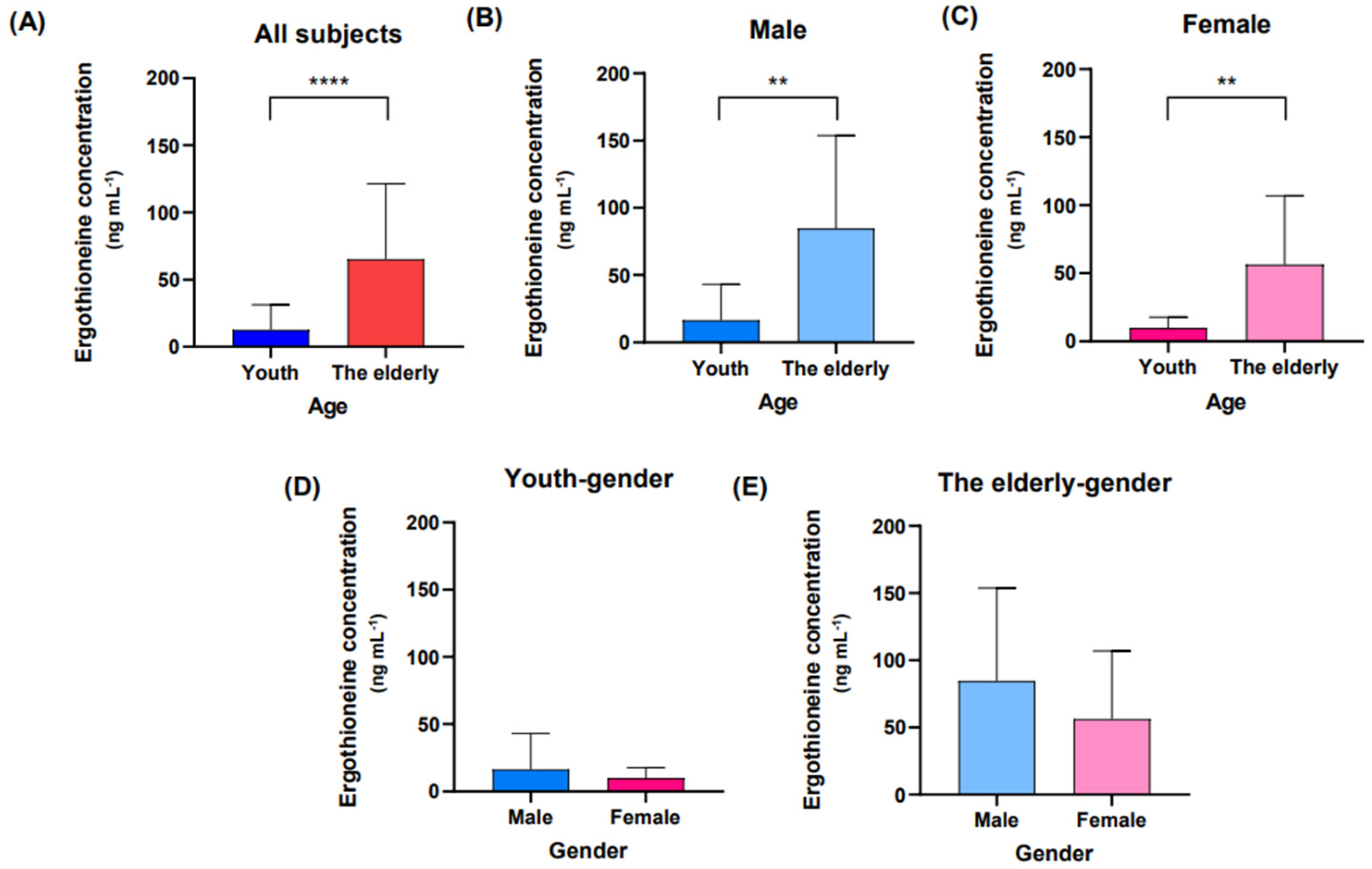
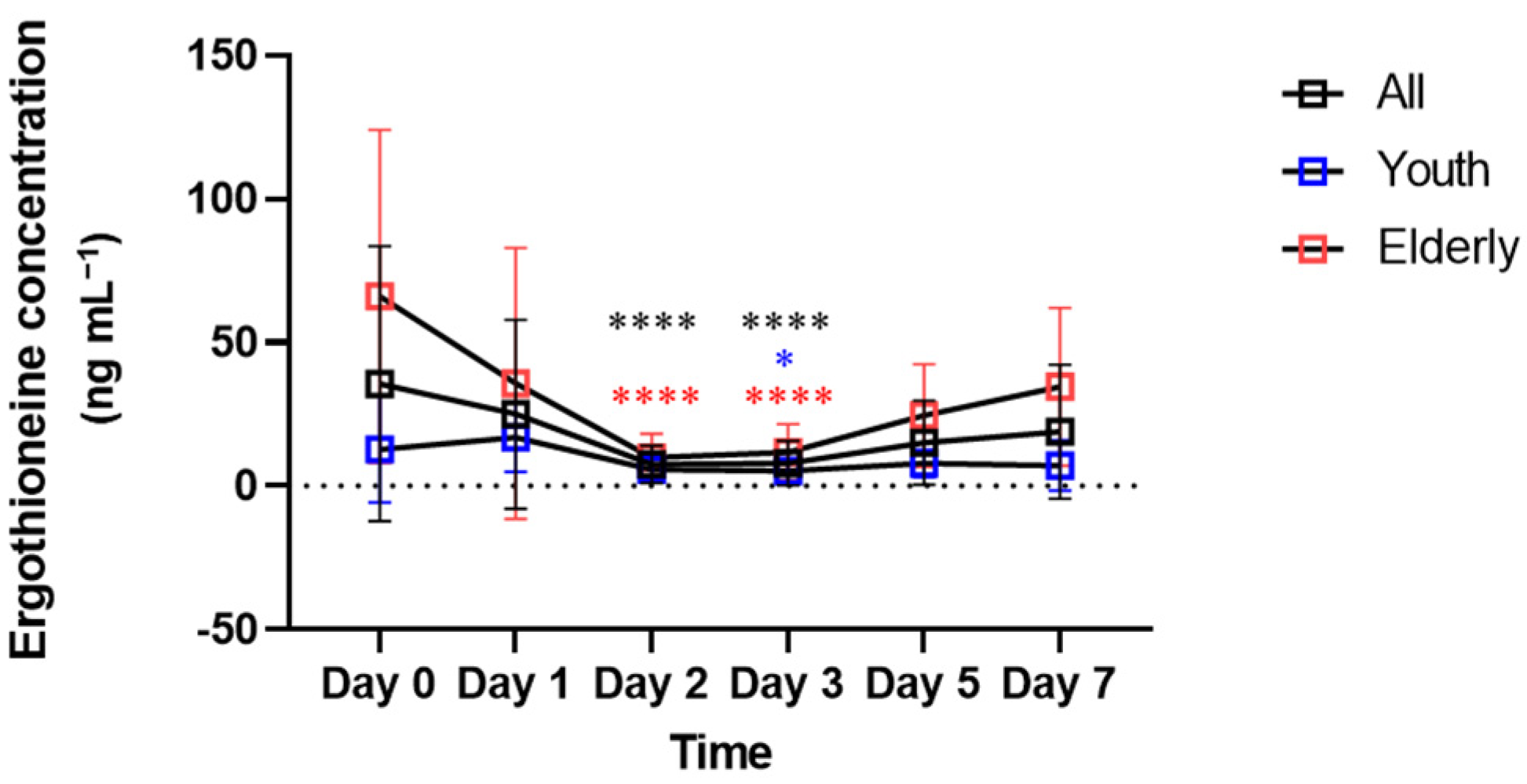
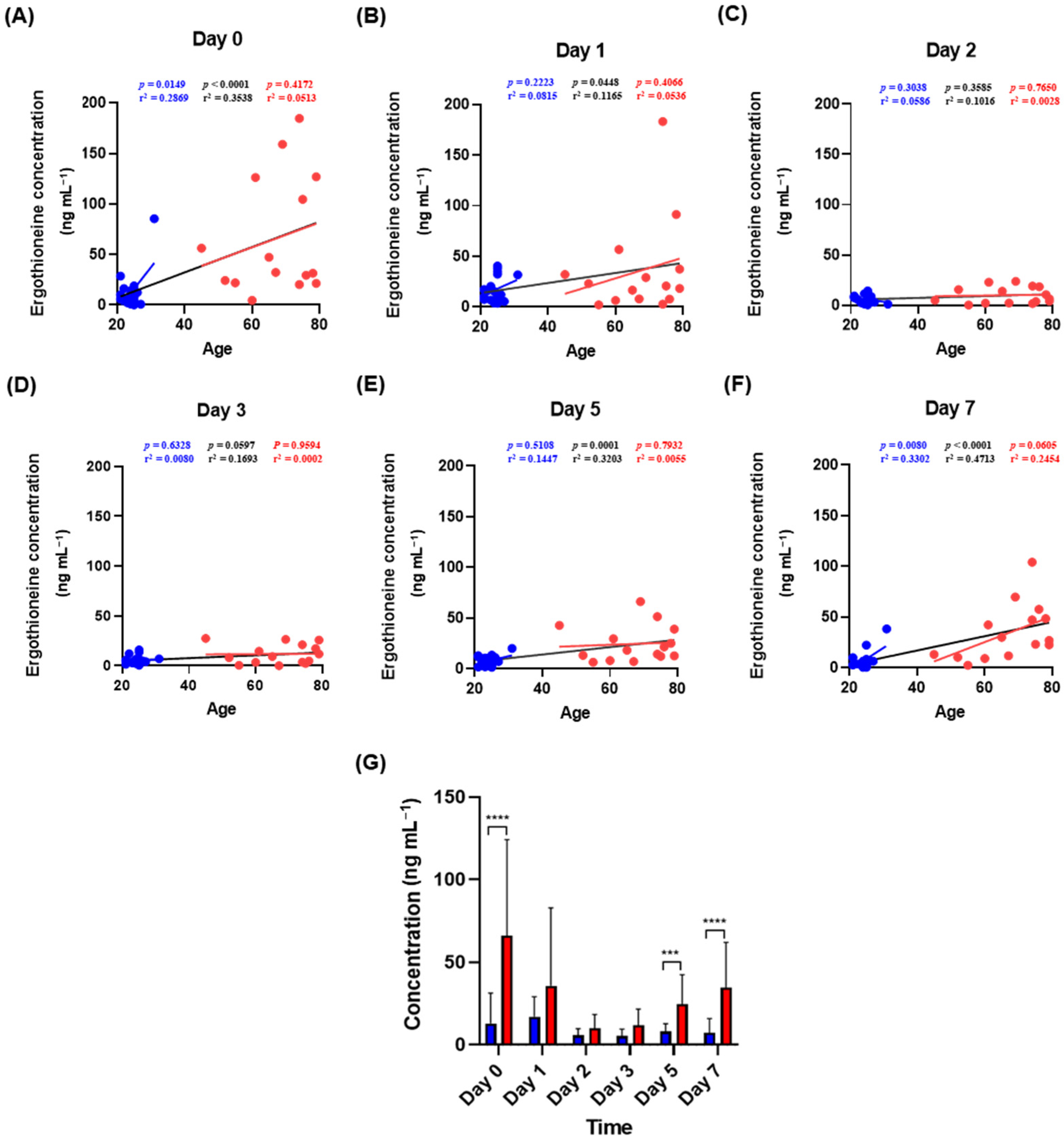
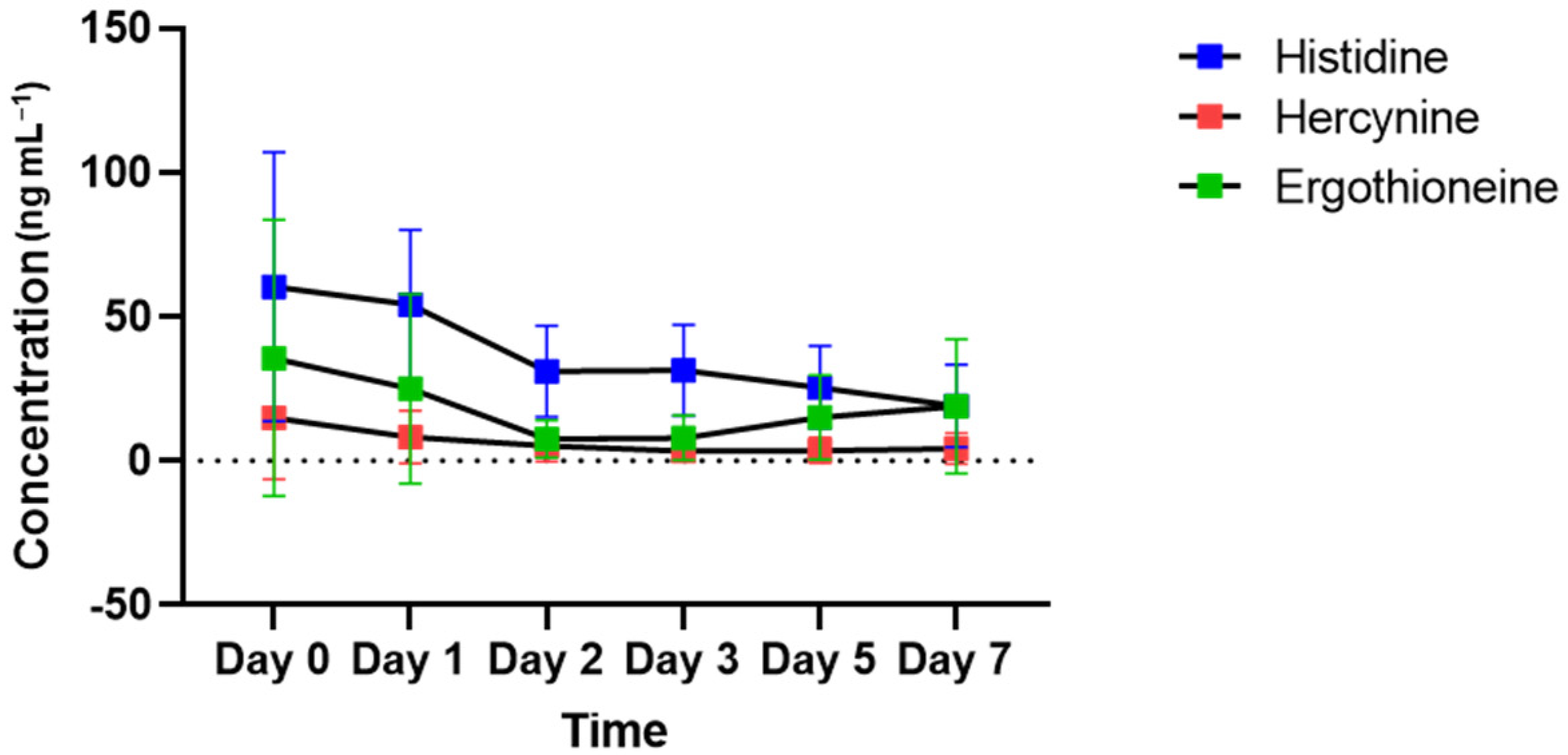
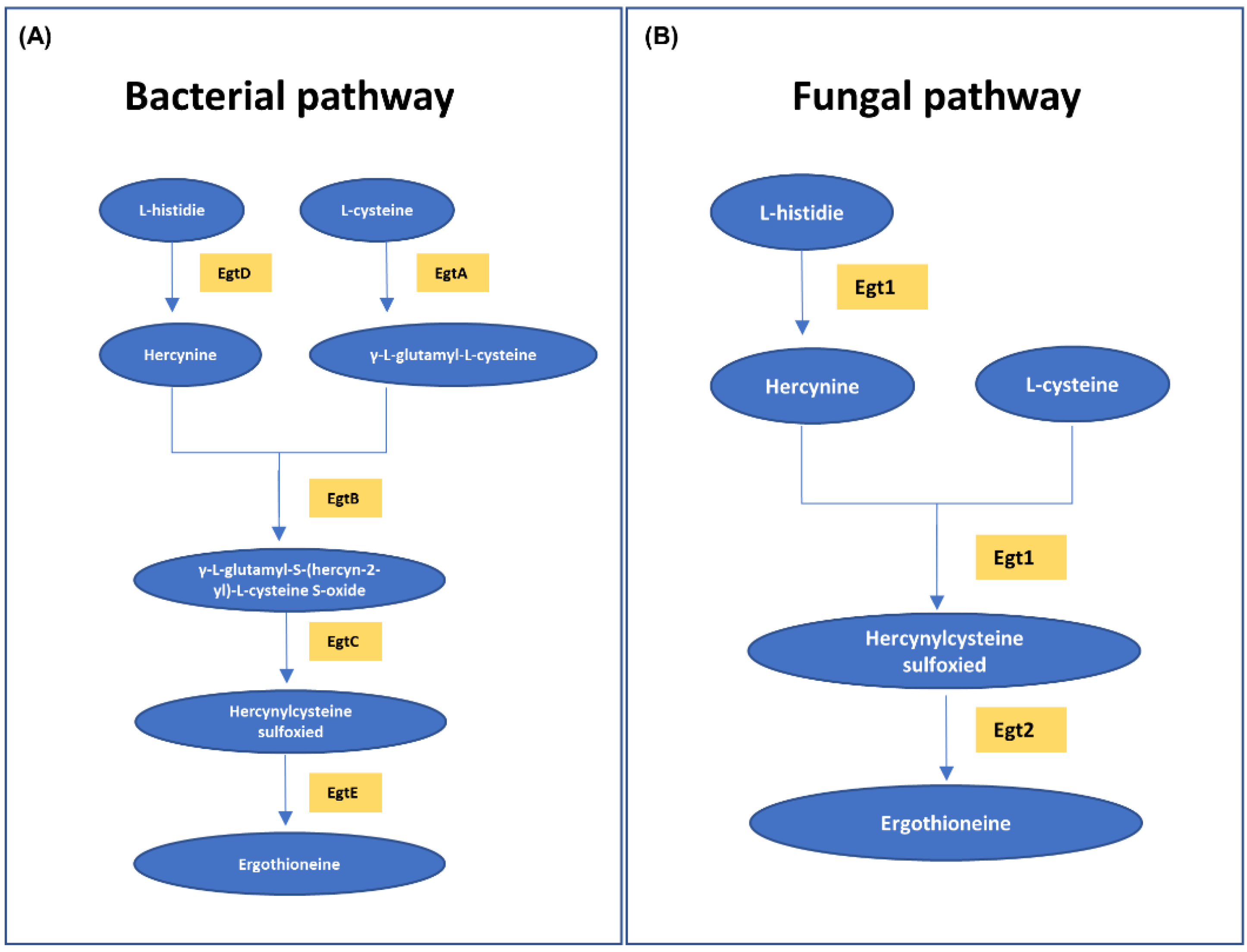

| Group | Youth | Elderly | p-Value |
|---|---|---|---|
| (n = 20) | (n = 15) | ||
| Age (mean ± standard deviation) | 24 ± 2 | 67 ± 11 | p < 0.05 a |
| Sex (male/female) | 9/11 | 5/10 | 0.486 b |
| Disease | 0 | 11 | |
| Smoking | 2 | 1 | |
| Fasting | >8 h | ||
| Analytes (Quantifier/Qualifier) | Q1 (Mass, Da) | Q3 (Mass, Da) | DP (V) | CE (eV) | EP (V) | CXP (V) |
|---|---|---|---|---|---|---|
| Ergothioneine (quantifier) | 230.066 | 186.100 | 46 | 17 | 10 | 12 |
| Ergothioneine (qualifier) | 230.066 | 127.100 | 206 | 25 | 10 | 12 |
| Ergothioneine-d9 (quantifier) | 239.124 | 127.100 | 106 | 27 | 10 | 10 |
| Ergothioneine-d9 (qualifier) | 239.124 | 195.200 | 106 | 17 | 10 | 12 |
| L-Hercynine (quantifier) | 197.957 | 95.100 | 61 | 27 | 10 | 4 |
| L-Hercynine (qualifier) | 197.957 | 60.100 | 16 | 19 | 10 | 4 |
| L-Hercynine-d3 (quantifier) | 200.770 | 95.100 | 71 | 29 | 10 | 8 |
| L-Hercynine-d3 (qualifier) | 200.770 | 63.200 | 71 | 21 | 10 | 8 |
| L-Histidine (quantifier) | 155.940 | 110.100 | 61 | 19 | 10 | 16 |
| L-Histidine (qualifier) | 155.940 | 56.100 | 61 | 43 | 10 | 4 |
| DL-Histidine-d3 (quantifier) | 158.878 | 113.200 | 56 | 19 | 10 | 6 |
| DL-Histidine-d3 (qualifier) | 158.878 | 57.100 | 56 | 27 | 10 | 10 |
Publisher’s Note: MDPI stays neutral with regard to jurisdictional claims in published maps and institutional affiliations. |
© 2022 by the authors. Licensee MDPI, Basel, Switzerland. This article is an open access article distributed under the terms and conditions of the Creative Commons Attribution (CC BY) license (https://creativecommons.org/licenses/by/4.0/).
Share and Cite
Lee, S.; Mun, S.; Lee, Y.-R.; Lee, J.; Kang, H.-G. Validation of the Metabolite Ergothioneine as a Forensic Marker in Bloodstains. Molecules 2022, 27, 8885. https://doi.org/10.3390/molecules27248885
Lee S, Mun S, Lee Y-R, Lee J, Kang H-G. Validation of the Metabolite Ergothioneine as a Forensic Marker in Bloodstains. Molecules. 2022; 27(24):8885. https://doi.org/10.3390/molecules27248885
Chicago/Turabian StyleLee, Seungyeon, Sora Mun, You-Rim Lee, Jiyeong Lee, and Hee-Gyoo Kang. 2022. "Validation of the Metabolite Ergothioneine as a Forensic Marker in Bloodstains" Molecules 27, no. 24: 8885. https://doi.org/10.3390/molecules27248885







